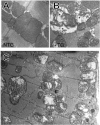Desmin-related cardiomyopathy: an unfolding story
- PMID: 21784990
- PMCID: PMC3197348
- DOI: 10.1152/ajpheart.00601.2011
Desmin-related cardiomyopathy: an unfolding story
Abstract
The intermediate filament protein desmin is an integral component of the cardiomyocyte and serves to maintain the overall structure and cytoskeletal organization within striated muscle cells. Desmin-related myopathy can be caused by mutations in desmin or associated proteins, which leads to intracellular accumulation of misfolded protein and production of soluble pre-amyloid oligomers, which leads to weakened skeletal and cardiac muscle. In this review, we examine the cellular phenotypes in relevant animal models of desmin-related cardiomyopathy. These models display characteristic sarcoplasmic protein aggregates. Aberrant protein aggregation leads to mitochondrial dysfunction, abnormal metabolism, and altered cardiomyocyte structure. These deficits to cardiomyocyte function may stem from impaired cellular proteolytic mechanisms. The data obtained from these models allow a more complete picture of the pathology in desmin-related cardiomyopathy to be described. Moreover, these studies highlight the importance of desmin in maintaining cardiomyocyte structure and illustrate how disrupting this network can be deleterious to the heart. We emphasize the similarities observed between desmin-related cardiomyopathy and other protein conformational disorders and speculate that therapies to treat this disease may be broadly applicable to diverse protein aggregation-based disorders.
Figures



References
-
- Bär H, Strelkov SV, Sjöberg G, Aebi U, Herrmann H. The biology of desmin filaments: how do mutations affect their structure, assembly, and organisation? J Struct Biol 148: 137–152, 2004 - PubMed
-
- Bence NF, Sampat RM, Kopito RR. Impairment of the ubiquitin-proteasome system by protein aggregation. Science 292: 1552–1555, 2001 - PubMed
-
- Brady JP, Garland DL, Green DE, Tamm ER, Giblin FJ, Wawrousek EF. αB-crystallin in lens development and muscle integrity: a gene knockout approach. Invest Ophthalmol Vis Sci 42: 2924–2934, 2001 - PubMed
-
- Capetanaki Y. Desmin cytoskeleton: a potential regulator of muscle mitochondrial behavior and function. Trends Cardiovasc Med 12: 339–348, 2002 - PubMed
Publication types
MeSH terms
Substances
Grants and funding
LinkOut - more resources
Full Text Sources
Other Literature Sources
Medical

